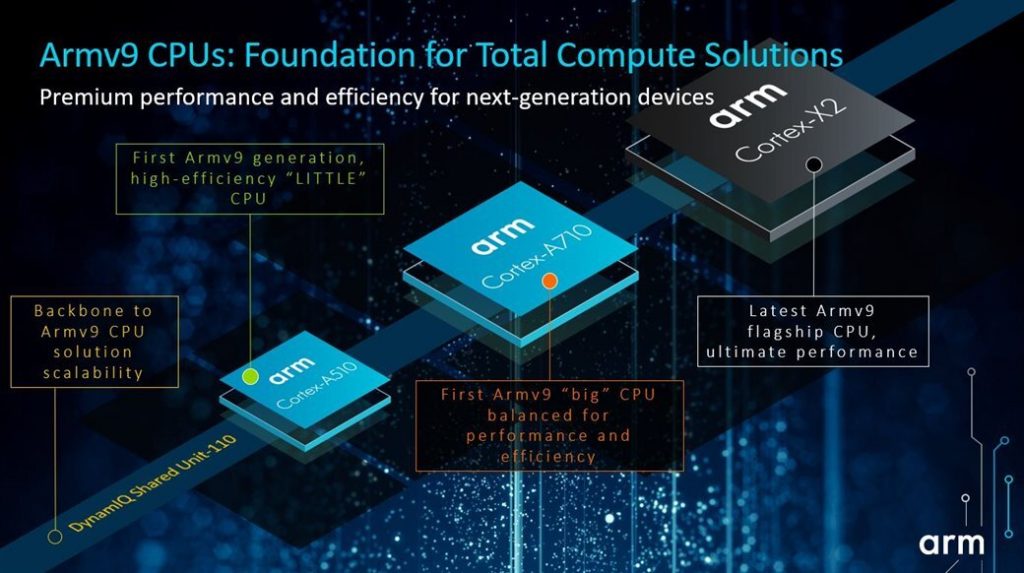
In 10 years, a new CPU was released that adopted the new ARM architecture version, Armv9. At the end of March, ARM announced Armv9, which will be the latest version of the ARM architecture used in smartphones around the world. Armv9 enables faster machine learning than before with SVE2 technology, and better hardware security through memory tag expansion.
Following this, three models of Cortex-X2, Cortex-A710, and Cortex-A510 were announced as new CPUs adopting Armv9. The Cortex-X2 is the Cortex-X1, the Cortex-A710 is the Cortex-A78, and the Cortex-A510 is the successor to the Cortex-A55. Cortex-X2 is said to have improved performance by 16%, Cortex-A710 by 10%, and Cortex-A510 by 35%. Machine learning performance is 3 times higher for Cortex-A510, 4 times higher for Cortex-A710 and 8 times higher for Cortex-X2.
Cortex-A55, which is a model before Cortex-A510, has been used as a smartphone processor since 2018. The Cortex-A510 adopts a smaller core than the previous model, with a 35% increase in performance and a 20% increase in efficiency. According to ARM, the Cortex-A510 is more powerful than the Cortex-A57 and closes to the Cortex-A73.

ARM has been developing the Cortex-A55 successor model that adopts Armv8. However, according to reports, ARM has been considering a plan to accelerate the release of the successor to the Armv8-based Cortex-A55, but instead switched to a policy that prioritizes the Armv9-based Cortex-A510.
The Cortex-A78 successor, the Cortex-A710, is located in the middle of ARM CPUs. It has as much computing power as the Cortex-X2, but it is more efficient. Compared to the previous model, Cortex-A78, the performance is 10% higher, but the efficiency is 30% higher.
The flagship model Cortex-X2 is the successor to the Cortex-X1 used in SoCs such as Qualcomm Snapdragon 888 and Samsung Electronics Exynos 2100. The Cortex-X2 offers 16% better performance than the X1. ARM also announced that it will completely abolish 32-bit support in smartphone processors in 2023. Among the three processors announced this time, the Cortex-A510 and X2 support 64-bit, while the Cortex-A710 supports 32-bit.
ARM also announced four other GPUs: Mali-G710, G610, G510, and G310. The flagship model, Mali-G710, has 16 cores, and compared to the previous model, Mali-G78, the number of cores has been reduced from 24 to 16, but machine learning performance has improved by 20% and efficiency by 35%.
The biggest difference from the Mali-G610, a GPU that has almost the same performance as the Mali-G710, is the number of shader cores. If there are more than 7 shader cores, it will be G710, and if it is Ewha, it will be G610. The Mali-G510 and G310 are cheaper entry-level GPUs, the successors of the Mali-G57 and Mali-G31 respectively. The Mali-G510 is more than 100% higher in performance, 22% more efficient, and 100% higher machine learning performance than the Mali-G57. Meanwhile, Mali-G310 improves texture performance by 6 times and Vulcan performance by 4.5 times compared to Mali-G31. In addition, ARM said that the Mali-G310 is expected to improve performance by 100% compared to the Mali-G31.
The four new GPUs feature all Valhall architectures, lossless compression, and ARM Fixed Rate Compression, which can reduce the bandwidth of content such as games and videos by 60% and improve performance by 80%. It is said that there will be. Related information can be found here.


















Add comment